|
HISTORY OF AZULEJOS
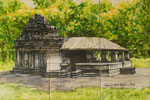 The most impressive example of Moorish Artistic influence is in the use of glazed, painted tiles called “Azulejos”, Azulejos was started in the 8th century by Islamic invasion. The Word 'Azulejos' is derived from the Arabic Word meaning “Smooth”. The use of these Arab-inspired surfaces is still important in today’s building, as the Tourist can see in modern Lisbon. The most impressive example of Moorish Artistic influence is in the use of glazed, painted tiles called “Azulejos”, Azulejos was started in the 8th century by Islamic invasion. The Word 'Azulejos' is derived from the Arabic Word meaning “Smooth”. The use of these Arab-inspired surfaces is still important in today’s building, as the Tourist can see in modern Lisbon.
|
|
Even with all this, the Arab Presence had not the significance in Portugal that it did in Spain. For one thing, it was a little over half as long in Time. For another, the Arab rulers in Portugal created nothing to compare with the great Kingdoms of Cordoba, Seville or Granada, so Productive in literature and Architecture. In Portugal we find no Dramatic Arab remains like the Alhambra or the Cordoba mosque.
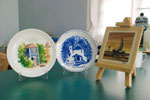 The Portuguese Tiles, Known as azulejos, adorn the inside and Outside of Almost every Home in Portugal, Portuguese and Flemish artist began to Produce tiles in Lisbon in 16th Century. blue and yellow were the Favorite color combinations and tiles depicted mostly floral patterns or religious scenes the ever expanding Portuguese empire Provided increasingly more exotic themes and colors. The Portuguese Tiles, Known as azulejos, adorn the inside and Outside of Almost every Home in Portugal, Portuguese and Flemish artist began to Produce tiles in Lisbon in 16th Century. blue and yellow were the Favorite color combinations and tiles depicted mostly floral patterns or religious scenes the ever expanding Portuguese empire Provided increasingly more exotic themes and colors.
Towards the end of the 17th century the fashion changed and Blue tiles became Popular. This was probably the craze for blue and white porcelain from china that was being imported into Europe at this time, This Association with Blue tiles tempts many to think that the word Azulejo comes from the Portuguese word for blue, but infact much older and has its origin in Arabic.
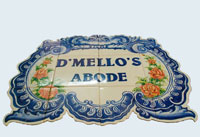 Pattern tiles have been used in numerous ways in Portugal on the Facades of the Smallest and the largest building, sometimes Plain and often with staggering richness. The entire insides of many churches are covered with beautifully painted Azulejos. Pattern tiles have been used in numerous ways in Portugal on the Facades of the Smallest and the largest building, sometimes Plain and often with staggering richness. The entire insides of many churches are covered with beautifully painted Azulejos.
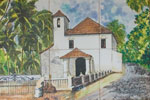 The Portuguese word for these tiles, approximately the same word the Spanish use is “Azulejo” The Art seems to have originated among the Assyrians in the times before Christ. From them it apparently was learned by the Persians, who taught it to the Arabs, who brought it to Europe through their invention of Iberia. The Portuguese word for these tiles, approximately the same word the Spanish use is “Azulejo” The Art seems to have originated among the Assyrians in the times before Christ. From them it apparently was learned by the Persians, who taught it to the Arabs, who brought it to Europe through their invention of Iberia.
|
|
|
MAKING OF TILES
|
|
 The Arabs established their first Factory for making of tiles in Sevilla, using their abstract designs, and the Portuguese, by then already more or less free of Arabic domination, made few purchases from there, which can be seen decorating the walls of the royal palace in sintra and also in the Quinta da Azeitaoon the main road of south from Lisbon. By this time Portugal had found its own personality, which artists wished to express in their own way. The divergence from the styles of the Spanish factories was also speeded By the winning of independence from Spain in a bitter war that ended in 1640 Resultly many tile factories were set up within Portugal, and During The seventeenth century Portugal became an important centre with Lisbon The Arabs established their first Factory for making of tiles in Sevilla, using their abstract designs, and the Portuguese, by then already more or less free of Arabic domination, made few purchases from there, which can be seen decorating the walls of the royal palace in sintra and also in the Quinta da Azeitaoon the main road of south from Lisbon. By this time Portugal had found its own personality, which artists wished to express in their own way. The divergence from the styles of the Spanish factories was also speeded By the winning of independence from Spain in a bitter war that ended in 1640 Resultly many tile factories were set up within Portugal, and During The seventeenth century Portugal became an important centre with Lisbon
The most important city for Azulejos.
By the eighteen century the Portuguese Europe in the Production of Azulejos, which is as much as to say that they led world in this artistic endeavor, and this was just the height they reached when the earthquake of 1755 destroyed the best factories and with it the Portuguese Leadership in the field.
|
|
AZULEJOS IN GOA
|
|
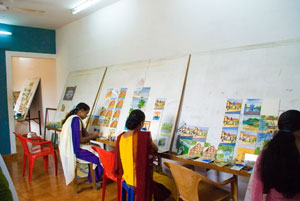 Azulejos in Goa was introduced by Portuguese, when Portuguese ruled over Goa for about 500 Years. It is a Portuguese Art form where in White tiles painted in blue shades and fired in an oven to fuse the color pigments permanently with the tile. Such tiles use to decorate the entrance walls. The influence of few we can see in Goa at the Menezes Braganza hall Panjim painted by Jorge Colaco, in the Old Goa church, Chinchinim in South Goa and in the few Portuguese Houses of Goa. Azulejos in Goa was introduced by Portuguese, when Portuguese ruled over Goa for about 500 Years. It is a Portuguese Art form where in White tiles painted in blue shades and fired in an oven to fuse the color pigments permanently with the tile. Such tiles use to decorate the entrance walls. The influence of few we can see in Goa at the Menezes Braganza hall Panjim painted by Jorge Colaco, in the Old Goa church, Chinchinim in South Goa and in the few Portuguese Houses of Goa.
When Portuguese left from Goa after Liberation in 1961. This Art form was completely abolished. Again it was reborn in Goa in 1998 by Goan Artist. Currently three Artist of Goa are still Engaged in this art to keep this Art still alive in Goa.
PROCESS OF MAKING AZULEJOS
First a biscuit of clay should be prepared, then it should be fired at 1200o centigrade temperature. Again it should be glazed and then Paint on it with ceramic colors And then again iy should be fired at 1200oc to fuse the color Pigments with the Tile.
Azulejos Tile Center
GHRSSIDC Shed no D2/13, Bicholim Industrial Estate
Bicholim - Goa 403 504
Tel : 91-832-2360062
Contact Person
Shankar Turi
|
|